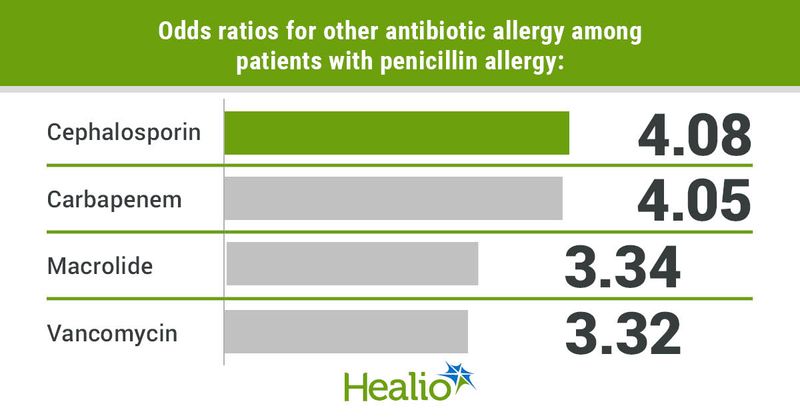Penicillin allergy may increase likelihood for other antibiotics allergies
Key takeaways:
- Cephalosporins and carbapenems were the most common allergies to coincide with penicillin allergies.
- Aminoglycosides showed the least increased likelihood.
People with penicillin allergies are more likely to have other antibiotic allergies than those without the allergy, according to a study published in Epic Research.
“We already knew that the documentation of a penicillin allergy was fairly common amongst patients. We wanted to understand if that was correlated with documented allergies to other types of antibiotics as well,” Kersten Bartelt, RN, research clinician with Epic Research, told Healio.


This study first examined data from 1,663,701 patients aged older than 18 years between July 1984 and December 2023 that were prescribed penicillin as well as an additional antibiotic. The patients needed to have a documented nonantibiotic allergy or no known allergies prior to receiving penicillin in the following year. Among the 31,319 patients with an established penicillin allergy, researchers conducted a 1:4 match with patients without the allergy based on antibiotic class, sex, race and ethnicity.
Study findings demonstrated that patients with a penicillin allergy showed a higher likelihood to also have an additional antibiotic allergy. The increased likelihood of being allergic to another antibiotic for those with a penicillin allergy included 308% to cephalosporins (OR = 4.08; 95% CI, 3.85-4.33), 305% to carbapenems (OR = 4.05; 95% CI 2.89-5.68), 234% to macrolides (OR = 3.34; 95% CI, 3.12-3.57) and 232% to vancomycin (OR = 3.32; 95% CI, 2.93-3.75), among others.
Since carbapenems typically are given to patients for less common infections caused by organisms that are resistant to multiple drugs, the researchers noted, they were used less frequently than the other antibiotics in the study, yielding a smaller population that could have been exposed to them.
The lowest increased likelihood occurred in aminoglycosides with a 152% likelihood (OR = 2.52; 95% CI, 2.26-2.81). Other antibiotics investigated included lincosamide (164%), sulfonamide (178%), nitrofurantoin (184%), quinolone (201%) and tetracycline (229%).
“These findings are significant because they highlight the increased risk of multiple antibiotic allergies in patients with a documented penicillin allergy,” Bartelt said. “This information is vital for health care providers when prescribing antibiotics to ensure patient safety and effective treatment.”
She further explained that doctors can use these findings to be more cautious when they prescribe antibiotics to patients who have a documented penicillin allergy and that alternative treatments should be considered. They should also closely monitor patients for potential allergic reactions to other antibiotics, particularly cephalosporins and carbapenems.
“This research can inform public health policy by emphasizing the importance of accurate allergy documentation and the need for alternative antibiotic strategies to prevent resistance,” Bartelt said. “Future research can focus on the mechanisms behind multiple antibiotic allergies.”

